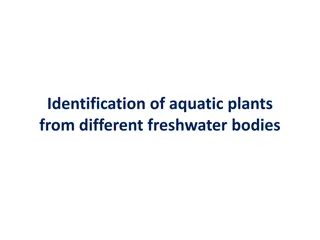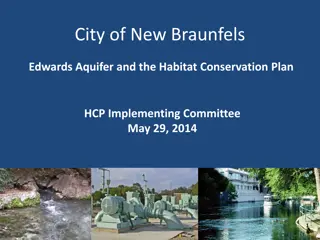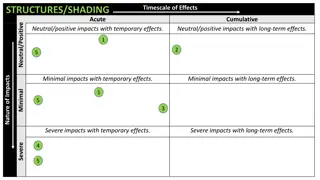Aquatic Therapy: Benefits, Techniques, and Research Findings
Aquatic therapy, presented by Beverly Knight, SPT, offers a unique approach to rehabilitation with properties of water like buoyancy and resistance. This therapy can benefit patients with various conditions such as chronic pain, arthritis, and neurological impairments. The content covers indications, contraindications, precautions, techniques like Aquatic PNF and Watsu, and research on conditions like Cerebral Palsy and Low Back Pain.
Download Presentation

Please find below an Image/Link to download the presentation.
The content on the website is provided AS IS for your information and personal use only. It may not be sold, licensed, or shared on other websites without obtaining consent from the author.If you encounter any issues during the download, it is possible that the publisher has removed the file from their server.
You are allowed to download the files provided on this website for personal or commercial use, subject to the condition that they are used lawfully. All files are the property of their respective owners.
The content on the website is provided AS IS for your information and personal use only. It may not be sold, licensed, or shared on other websites without obtaining consent from the author.
E N D
Presentation Transcript
AQUATIC THERAPY: Beverly Knight, SPT UNC DPT 2014
Objectives Identify therapeutic properties of water. 1. 2. Identify contraindications and precautions to aquatic therapy. 3. Identify patients that may benefit from aquatic therapy. 4. Provide current literature on the benefits of aquatic therapy for different impairments and diagnoses.
Properties of Water2 Buoyancy Hydrostatic Pressure Viscosity/Resistance Hydrodynamics Temperature Turbulence
Indications6 Pain (Acute/chronic) Pre-surgical preparation Post-surgical rehabilitation Fibromyalgia Arthritis Orthopedic Conditions Multiple Sclerosis Obesity Osteoporosis Balance Disorders Weakness/Coordination deficits Chronic Fatigue Syndrome Poor Gait, Fear of Falling Neurological impairments
Contraindications6 Open Wounds Skin Infection Fever Incontinence Contagious infections/disease Unstable Angina Uncontrolled Epilepsy Tracheotomy Acute DVT/Pulmonary Embolism Vomiting or Diarrhea
Precautions6 Unstable Blood Pressure Hydrophobia HIV Epilepsy Ostomy IV site Low Endurance Conditions Severe Impulsivity Current Radiation/Severe Burns Inability for Thermal Regulation Excessive or hypersensitivity to chlorine Perforated Eardrum
Aquatic Techniques6,7 Bad Ragaz Ring Method Aquatic PNF Halliwick Watsu Back Hab Ai Chi Aquatic Trunk Stabilization Unpredictable Command Technique Water Yoga Aquatic Pilates
Research/Literature Review Cerebral Palsy Low Back Pain Osteoarthritis Total Joint Replacement
Aquatic Therapy: Making a Wave in the Treatment of Low Back Injuries2 Konlian (1999) aimed to increase knowledge and understanding of aquatic therapy for patients and designed this article for nurses and other health care professionals who work with patients involved in aquatic therapy. She provides the history of hydrotherapy, incidence of low back injuries and the benefits of aquatic medium for spinal patients. She suggests components of an aquatic program for spinal patients and incorporates specific exercise like deep water exercises, spinal stabilization with swimming, underwater treadmills. It is concluded that aquatic exercise can be used to prevent deconditioning, maintain one s overall fitness level during the healing stage and increase ROM, strength and endurance.
Aquatic Therapy & Cerebral Palsy8 Thorpe and Reilly (2000) examine the effectiveness of an aquatic progressive resistive exercise program on lower extremity strength, functional mobility, energy expenditure, functional balance and self perception in 31 year old male with spastic diplegic cerebral palsy (CP). He participated in a 10 week of aquatic resistive exercise program that resulted in his ability to ambulate ~20 without AD, stand without AD to complete the FRT and increased velocity of gait (3m/min); demonstrated average strength gains of 100% in all LE muscle groups except R hip flexors.
Effects of Aquatic Aerobic Exercise For A Child With Cerebral Palsy: Single-Subject Design5 Ratarekar et al. (2009) evaluated the effects of an aquatic aerobic program for a 5 year old girl with spastic diplegia. The program consisted of aquatic aerobic exercise 3x/week for 12 weeks at an intensity of 50-80% of HR reserve. The COPM, GMFM and 6-min walk test were the outcomes utilized. Improvements in functional abilities and walking endurance and speed were noted, along with statistically improvements in the participation, activity and body function components of the ICF model.
Aquatic Physical Therapy for Hip and Knee Osteoarthritis: Results of a Single-Blind Randomized Controlled Trial1 Hinman et al. (2007) evaluated the effects of aquatic therapy on hip and knee OA utilizing 71 volunteers with symptomatic hip OA or knee OA in a single-blind RCT. It was shown that a 6 week aquatic physical therapy intervention vs. no aquatic physical therapy resulted in less pain and joint stiffness and greater physical function, quality of life, and hip muscle strength. Totals of 72% and 75% of participants reported improvements in pain and function, respectively, compared with only 17% (each) of control participants. Benefits were maintained 6 weeks after the completion of physical therapy, with 84% of participants continuing independently.
A specific inpatient aquatic physiotherapy program improves strength after total hip or knee replacement surgery: a randomized controlled trial4 Rahmann et al (2009) evaluated the effect of inpatient aquatic physiotherapy in addition to usual ward physiotherapy on the recovery of strength, function, and gait speed after total hip or knee replacement surgery. This RCT involved 65 patients undergoing primary hip or knee arthrosplasty. Participants were randomly assigned to received supplementary inpatient physiotherapy, beginning on day 4: aquatic physiotherapy, nonspecific water exercise or additional ward physiotherapy. The main outcome measures were strength, gait speed and functional ability at day 14. At day 14, hip abductor strength was significantly greater after aquatic physiotherapy.
Timing of Aquatic Therapy after Total Joint Replacement3 Liebs et al (2012) evaluated how the timing (6 days vs. 14 days post-op) of aquatic therapy influences patients' health-related quality of life and patient satisfaction after hip and knee arthroscopy. This multicenter randomized controlled trial utilized 465 patients undergoing primary THA or TKA. Early start of aquatic therapy had contrary effects after TKA when compared with THA and it influenced clinical outcomes after TKA. Though the treatment differences did not achieve statistically significance, the effect size for early aquatic therapy after TKA had the same magnitude as the effect size of nonsteroidal anti-inflammatory drugs in the treatment of osteoarthritis of the knee. the results of. This study does not support the use of early aquatic therapy after THA.
Video: Waterproof Dressing Opsite Waterproofing & HydroWorx Aquatic Therapy http://www.youtube.com/watch?feature=player_detail page&v=B1TE2R-vkbc
References Hinman R, Heywood S, Day A. Aquatic physical therapy for hip and knee osteoarthritis: results of a single-blind randomized controlled trial. Physical Therapy [serial online]. 2007;87(1):32-43. Available from: CINAHL with Full Text, Ipswich, MA. Accessed June 15, 2013. Konlian, Cara. Aquatic Therapy: Making a Wave in the Treatment of Low Back Injuries. Orthopaedic Nursing. January/February 1999:11-18. Accessed May 15, 2013. Liebs T. Multicenter randomized controlled trial comparing early versus late aquatic therapy after total hip or knee arthroplasty. Archives of physical medicine and rehabilitation. 2012-02;93:192-9. Rahmann A. A specific inpatient aquatic physiotherapy program improves strength after total hip or knee replacement surgery: a randomized controlled trial. Archives of Physical Medicine and Rehabilitation. 2009-05;90:745-55. Retarekar R. Effects of aquatic aerobic exercise for a child with cerebral palsy: single-subject design. Pediatric Physical Therapy. 2009;21:336-44. Salzman, A. Aquatic Therapy. Aquatic Net: Aquatic Resources Network.Available at://www.aquaticnet.com/articles.htm. Accessed June 1, 2013. Sova, R. Aquatic Therapy. National Center on Health, Physical Activity, and Disability website.2013. Available at:http://www.ncpad.org/223/1456/Aquatic~Therapy. Accessed June 4, 2013. Thorpe, D. E., and M. Reilly. The effect of an aquatic resistive exercise program on lower extremity strength, energy expenditure, functional mobility, balance and self-perception in an adult with cerebral palsy: a retrospective case report. J Aquatic Phys Ther 8.2 (2000): 18-24. 1. 2. 3. 4. 5. 6. 7. 8.
Survey Did this presentation follow the listed objectives? Y/N Did you learn something new you didn t know about aquatic physical therapy? Y/N Any suggestions on how to improve this presentation? Constructive Feedback:























